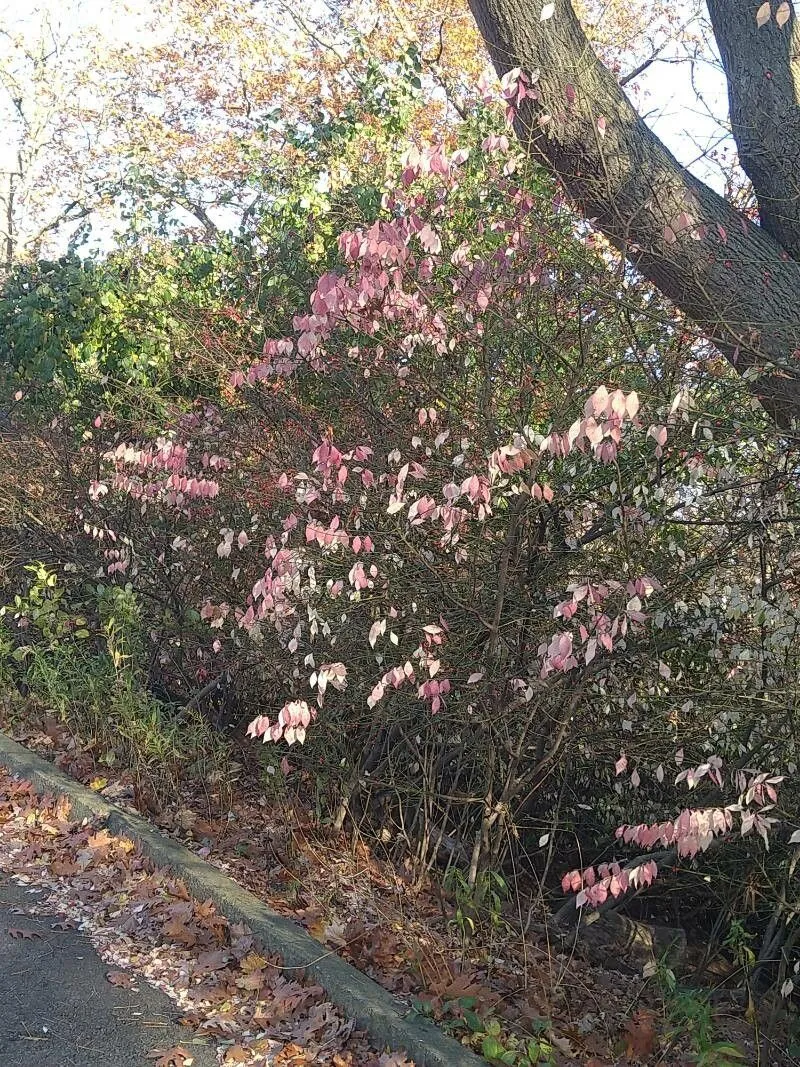
Author: (Thunb.) Siebold
Bibliography: Verh. Batav. Genootsch. Kunsten 12: 49 (1830)
Year: 1830
Status: accepted
Rank: species
Genus: Euonymus
Vegetable: False
Observations: S. Siberia to Japan and China
The Burningbush is an enchanting shrub known scientifically as Euonymus alatus. This aesthetically pleasing plant thrives across a significant range, stretching from South Siberia to Japan and China. It holds a prominent place within the Celastraceae family, renowned for its unique appearance and adaptability in various landscapes.
First classified in the early 19th century, Euonymus alatus was carefully documented by Thunberg and later updated by Siebold in the “Verhandlungen der Batavischen Gesellschaft der Künste und Wissenschaften,” an authoritative work published in 1830. This historical reference highlights the long-standing recognition of the plant’s distinct characteristics and its relevance in botanical studies.
The Burningbush captures attention with its striking, vibrant foliage, particularly during the autumn months when its leaves turn a vivid crimson or purplish-red, creating a mesmerizing spectacle. This dramatic color transformation makes it a popular choice for gardeners and landscape designers aiming to add a splash of seasonal color to their outdoor spaces.
Structurally, the shrub is notable for its corky winged branches, a feature that distinguishes it from other members of the Celastraceae family. This attribute not only adds to its visual appeal but also contributes to its resilience and adaptability. The plant is known for its hardiness and can flourish in a variety of soil conditions, making it a versatile addition to gardens in temperate regions.
Beyond its ornamental use, Euonymus alatus holds ecological significance. It can provide shelter and food for various wildlife species, thus contributing to biodiversity in the areas where it is cultivated. Despite its beauty and benefits, it should be noted that in some regions, the Burningbush has become invasive, prompting considerations for management to prevent it from overshadowing native flora.
In summary, the Burningbush, or Euonymus alatus, is a remarkable shrub celebrated for its vibrant seasonal color and unique physical attributes. Rooted in a rich botanical history, it continues to captivate and serve both aesthetic and ecological roles across its native and introduced ranges.
Eng: burning bush, burningbush, winged burning bush, winged euonymus, winged spindletree, oriental spindle-tree, winged burning-bush, winged spindle-tree
Deu: flügel-spindelstrauch
Fra: fusain ailé
Swe: vingbenved
En: Burningbush, Winged euonymus, Winged spindletree, Winged burning bush, Burning bush, Oriental spindle-tree, Winged burning-bush, Winged spindle-tree
Fr: Fusain ailé
De: Flügel-Spindelstrauch
Ja: Nishikigi
Sv: Vingbenved
© copyright of the Board of Trustees of the Royal Botanic Gardens, Kew.
© copyright of the Board of Trustees of the Royal Botanic Gardens, Kew.
© copyright of the Board of Trustees of the Royal Botanic Gardens, Kew.
Taken Jan 8, 2020 by AnnA (cc-by-sa)
Taken Nov 2, 2021 by Maud Guérin (cc-by-sa)
Taken Apr 24, 2021 by Adam Covey (cc-by-sa)
Taken Apr 26, 2022 by Marie Gwynne (cc-by-sa)
Taken Jul 22, 2022 by Oğuzhan (cc-by-sa)
Taken Nov 7, 2022 by Maritche (cc-by-sa)
Taken Sep 30, 2022 by Fabrice Rubio (cc-by-sa)
Taken Sep 30, 2022 by Fabrice Rubio (cc-by-sa)
Taken Sep 30, 2022 by Fabrice Rubio (cc-by-sa)
Taken Sep 30, 2022 by Fabrice Rubio (cc-by-sa)
Taken Nov 7, 2022 by Maritche (cc-by-sa)
Taken Sep 30, 2022 by Fabrice Rubio (cc-by-sa)
Taken Sep 30, 2022 by Fabrice Rubio (cc-by-sa)
Taken Sep 30, 2022 by Fabrice Rubio (cc-by-sa)
Taken Sep 30, 2022 by Fabrice Rubio (cc-by-sa)
Taken Nov 13, 2021 by susan white (cc-by-sa)
Taken Oct 22, 2022 by John Dyck (cc-by-sa)
Taken Nov 18, 2021 by Tracie Campbell (cc-by-sa)
Taken Oct 14, 2021 by Lola Rodriguez Del cid (cc-by-sa)
Taken Jul 6, 2021 by Rebecca Levy (cc-by-sa)
Taken Nov 5, 2003 by EOL − Steven J. Baskauf (cc-by-nc-sa)
Taken Jun 1, 2020 by Martet Chach (cc-by-sa)
Taken Jul 22, 2022 by Oğuzhan (cc-by-sa)
Taken Nov 6, 2022 by Emily LaPrairie (cc-by-sa)
Taken Sep 30, 2022 by Fabrice Rubio (cc-by-sa)
Taken May 2, 2021 by Chase Hammack (cc-by-sa)
Taken Nov 18, 2021 by eesullivan (cc-by-sa)
Taken Apr 22, 2020 by Beth Bojarski (cc-by-sa)
Taken Nov 23, 2021 by Marie Dubé (cc-by-sa)
Taken Nov 29, 2019 by Martin (cc-by-sa)
Growth form: Rhizomatous
Growth habit: Shrub
Growth rate: Moderate
Ph maximum: 7.0
Ph minimum: 4.0
Family: Myrtaceae Author: (F.Muell.) K.D.Hill & L.A.S.Johnson Bibliography: Telopea 6: 402 (1995) Year: 1995 Status:…
Family: Rubiaceae Author: Pierre ex A.Froehner Bibliography: Notizbl. Bot. Gart. Berlin-Dahlem 1: 237 (1897) Year:…
Family: Sapindaceae Author: Koidz. Bibliography: J. Coll. Sci. Imp. Univ. Tokyo 32(1): 38 (1911) Year:…
Family: Asteraceae Author: A.Gray Bibliography: Pacif. Railr. Rep.: 107 (1857) Year: 1857 Status: accepted Rank:…
Family: Fabaceae Author: Medik. Bibliography: Vorles. Churpfälz. Phys.-Ökon. Ges. 2: 398 (1787) Year: 1787 Status:…
Family: Aspleniaceae Author: (Cav.) Alston Bibliography: Bull. Misc. Inform. Kew 1932: 309 (1932) Year: 1932…